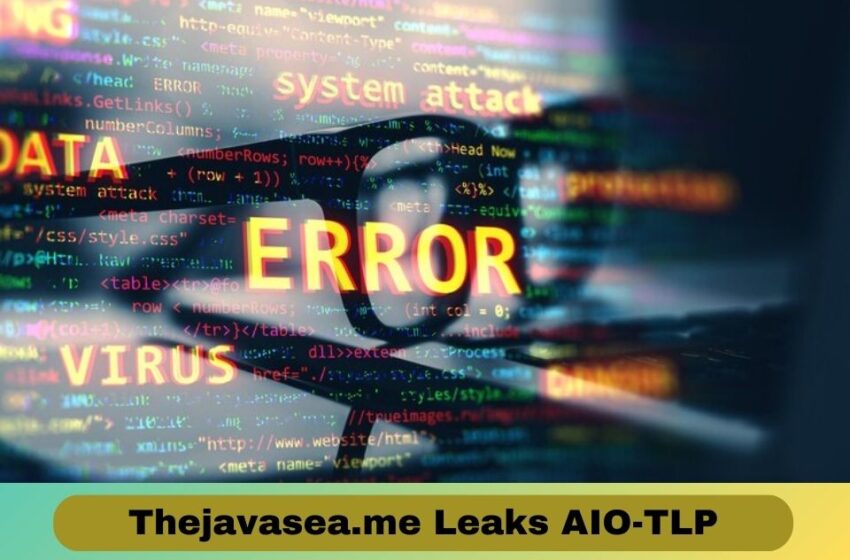Thejavasea.me Leaks AIO-TLP: An Insightful Guide Into The Leak & Its Impact

In an era where data is the backbone of digital operations, breaches and leaks create ripples that affect individuals, corporations, and governments alike. One such event—the AIO-TLP leak on thejavasea.me—has brought critical attention to the risks of data misuse and the vulnerabilities of digital systems. This guide delves into the meaning of AIO-TLP, the impact of such leaks, and strategies to mitigate risks arising from unauthorized data exposure.
What Does AIO-TLP Mean?
AIO-TLP is a multifaceted term that combines two crucial concepts:
All-In-One (AIO)
Refers to bundled resources, tools, or data sets. These are often consolidated to offer comprehensive functionality in a single package, making them attractive targets for unauthorized access.
Traffic Light Protocol (TLP)
A classification system used to regulate the dissemination of sensitive information. TLP uses four distinct labels:
Red: Information is restricted to direct recipients only.
Amber: Data can be shared under controlled circumstances.
Green: Meant for a specific community but not publicly distributed.
White: Free for public access and dissemination.
In the context of thejavasea.me leaks, the blend of AIO’s comprehensive scope with TLP’s confidentiality highlights the gravity of the exposed data.
Anatomy Of the Thejavasea.me Leaks AIO-TLP
The AIO-TLP leak on thejavasea.me comprises a wide range of information, including corporate documents, private conversations, and personal user data. This breach has sent shockwaves through the digital landscape, with implications spanning from individual privacy violations to corporate espionage.
The leak demonstrates how cybercriminals exploit weak points in digital infrastructure to extract and disseminate valuable or sensitive information. Unlike traditional breaches, this leak stands out because of its organized nature, targeting data categorized under TLP protocols, thereby amplifying its potential misuse.
Data Categories Exposed In The Leak
The leaked information spans various domains, underscoring the need for better digital security. Key categories include:
Corporate Data
- Internal communications, including emails and project details.
- Financial records, exposing organizations to fraud risks.
Personal Information
- Names, addresses, and contact details.
- Sensitive data such as financial credentials and identity documents.
Government Documents
- Confidential state communications and classified files.
- Strategic operational data, potentially jeopardizing national security.
Technical Resources
- Proprietary software tools and technical documentation.
- APIs and codebases that could facilitate unauthorized developments.
Why Are Thejavasea.me Leaks AIO-TLP Leaks Significant?
Erosion Of Trust
Data leaks undermine trust between users and platforms, affecting relationships between businesses and their clients. Users often expect platforms to safeguard their data, and breaches shatter that confidence.
Financial & Reputational Losses
For organizations, the exposure of proprietary data and operational details can lead to financial setbacks, legal battles, and long-term reputational damage.
Risk Of Exploitation
Hackers and bad actors exploit leaked data for various malicious purposes, including identity theft, fraud, and unauthorized financial transactions.
How To Respond To Data Leaks
- Immediate Action: As soon as a data leak is identified, entities must act quickly to secure compromised systems, change access credentials, and notify affected parties.
- Engage Cybersecurity Experts: Consulting with cybersecurity professionals helps identify the root cause of the breach and implement robust defenses to prevent recurrence.
- Transparency with Users: Organizations must maintain clear communication with users about the breach and guide them on safeguarding their own information.
- Legal Recourse: Seeking legal intervention can deter further misuse of leaked data and hold perpetrators accountable.
Preventing Future Breaches
- Strengthening Encryption Protocols: Modern encryption algorithms can safeguard data, making it nearly impossible for unauthorized parties to access information without proper authorization.
- Regular Security Audits: Frequent assessments of digital infrastructure help identify vulnerabilities and allow for timely fixes.
- User Awareness Programs: Educating users on recognizing phishing attempts and maintaining digital hygiene reduces the likelihood of data exposure through user error.
- Adopting Zero Trust Architecture: A zero-trust approach ensures that no entity is trusted by default, even within the network. This minimizes access points for potential attackers.
Ethical Implications Of The Leak
While leaks like AIO-TLP may sometimes expose corruption or unethical practices, the collateral damage cannot be ignored. Innocent parties often bear the brunt of such breaches, facing risks of identity theft, financial loss, and reputational harm. Furthermore, the unregulated nature of leaked data dissemination raises questions about the moral responsibility of those who access and share such information.
Final Words
The AIO-TLP leak on thejavasea.me serves as a stark reminder of the vulnerabilities inherent in our digital ecosystems. From personal data to corporate secrets, no domain is immune to the risks posed by breaches. While the leak may have exposed flaws in existing systems, it also offers an opportunity to reassess and fortify our approach to data security. By prioritizing transparency, ethical considerations, and robust cybersecurity measures, we can better navigate the challenges posed by an interconnected world.
FAQs
What is the significance of TLP in the AIO-TLP leak?
TLP (Traffic Light Protocol) governs how sensitive information is classified and shared, highlighting the severity of the data exposed.
How does the AIO-TLP leak affect individuals?
Individuals may face identity theft, financial fraud, and loss of privacy due to their exposed personal information.
Can organizations recover from such a data leak?
Yes, with timely action, strong cybersecurity measures, and transparent communication, organizations can mitigate the impact and rebuild trust.